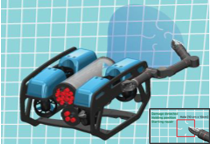AQUASTAR: AUTONOMOUS UNDERWATER SYSTEM FOR TARGETED ASSESSMENT AND REPAIR
Introduction
The AQUASTAR project targets combined autonomous inspection and repair of holes in sea-based aquaculture net pens . Holes in the net represent the main reason for fish escape and is a challenge in aquaculture fish farming in traditional net pens.
Motivation
N et inspections are currently carried out manually and include a remotely operated vehicle (ROV) and an ROV pilot. However, inspecting net patterns for hours on end is tedious and can increase the risk of overlooking holes. Divers are usually employed for repair; however, they are exposed to risks that may lead to injuries and even death . This strongly advocates for both enhanced hole detection systems and alternative net repair solutions.
The AQUASTAR project will develop solutions for ROVs with manipulators enabling automatic hole localization , automatic vehicle positioning and hole repair . This will serve as a tool for ROV pilots to ac hieve enhanced net inspections and the opportunity to immediately repair holes in the net.
Project status and project results
AQUASTR has developed and tested a net-relative navigation system that allows for horizontal and vertical movement and station keeping relative to the net. T he project has also developed a fully operational automatic hole detection system , which , to the best of the project consortium’s knowledge, marks the first time hole detection is being used commercially . There is an on-going process of gathering images of holes in the net that will be published as open-source datasets. The datasets will include several varying conditions present in aquaculture, (e.g., different illumination, turbidity and biofouling conditions . Moving further, the project aims to develop hole-relative station k eeping and control strategies for combined vehicle-manipulator systems for hole repair.
Acknowledgments
The AQUASTAR project is an industrial research and collaboration project between Njord Aqua, Måsøval, Sintef Ocean, and NTNU, and is supported by the Research Council of Norway.

